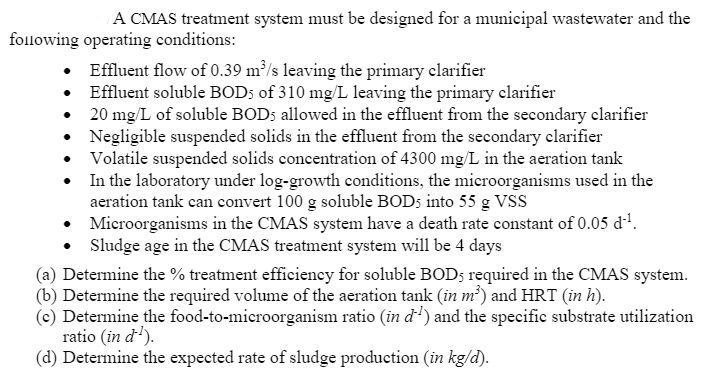A CMAS treatment system must be designed for a municipal wastewater and the following operating conditions: • Effluent flow of 0.39 m³/s leaving the primary clarifier • Effluent soluble BOD5 of 310 mg/L leaving the primary clarifier 20 mg/L of soluble BOD5 allowed in the effluent from the secondary clarifier Negligible suspended solids in the effluent from the secondary clarifier Volatile suspended solids concentration of 4300 mg/L in the aeration tank In the laboratory under log-growth conditions, the microorganisms used in the aeration tank can convert 100 g soluble BOD5 into 55 g Vss Microorganisms in the CMAS system have a death rate constant of 0.05 d. Sludge age in the CMAS treatment system will be 4 days (a) Determine the % treatment efficiency for soluble BOD5 required in the CMAS system. (b) Determine the required volume of the aeration tank (in m²) and HRT (in h). (c) Determine the food-to-microorganism ratio (in d') and the specific substrate utilization ratio (in d'). (d) Determine the expected rate of sludoe production (in kgld).
A CMAS treatment system must be designed for a municipal wastewater and the following operating conditions: • Effluent flow of 0.39 m³/s leaving the primary clarifier • Effluent soluble BOD5 of 310 mg/L leaving the primary clarifier 20 mg/L of soluble BOD5 allowed in the effluent from the secondary clarifier Negligible suspended solids in the effluent from the secondary clarifier Volatile suspended solids concentration of 4300 mg/L in the aeration tank In the laboratory under log-growth conditions, the microorganisms used in the aeration tank can convert 100 g soluble BOD5 into 55 g Vss Microorganisms in the CMAS system have a death rate constant of 0.05 d. Sludge age in the CMAS treatment system will be 4 days (a) Determine the % treatment efficiency for soluble BOD5 required in the CMAS system. (b) Determine the required volume of the aeration tank (in m²) and HRT (in h). (c) Determine the food-to-microorganism ratio (in d') and the specific substrate utilization ratio (in d'). (d) Determine the expected rate of sludoe production (in kgld).
Chapter2: Loads On Structures
Section: Chapter Questions
Problem 1P
Related questions
Question

Transcribed Image Text:A CMAS treatment system must be designed for a municipal wastewater and the
following operating conditions:
• Effluent flow of 0.39 m³/s leaving the primary clarifier
Effluent soluble BOD; of 310 mg/L leaving the primary clarifier
20 mg/L of soluble BOD5 allowed in the effluent from the secondary clarifier
Negligible suspended solids in the effluent from the secondary clarifier
• Volatile suspended solids concentration of 4300 mg/L in the aeration tank
• In the laboratory under log-growth conditions, the microorganisms used in the
aeration tank can convert 100 g soluble BODS into 55 g VSS
• Microorganisms in the CMAS system have a death rate constant of 0.05 d'.
Sludge age in the CMAS treatment system will be 4 days
(a) Determine the % treatment efficiency for soluble BOD; required in the CMAS system.
(b) Determine the required volume of the aeration tank (in m²) and HRT (in h).
(c) Determine the food-to-microorganism ratio (in d') and the specific substrate utilization
ratio (in d').
(d) Determine the expected rate of sludge production (in kg/d).
Expert Solution
This question has been solved!
Explore an expertly crafted, step-by-step solution for a thorough understanding of key concepts.
This is a popular solution!
Trending now
This is a popular solution!
Step by step
Solved in 4 steps

Knowledge Booster
Learn more about
Need a deep-dive on the concept behind this application? Look no further. Learn more about this topic, civil-engineering and related others by exploring similar questions and additional content below.Recommended textbooks for you


Structural Analysis (10th Edition)
Civil Engineering
ISBN:
9780134610672
Author:
Russell C. Hibbeler
Publisher:
PEARSON

Principles of Foundation Engineering (MindTap Cou…
Civil Engineering
ISBN:
9781337705028
Author:
Braja M. Das, Nagaratnam Sivakugan
Publisher:
Cengage Learning


Structural Analysis (10th Edition)
Civil Engineering
ISBN:
9780134610672
Author:
Russell C. Hibbeler
Publisher:
PEARSON

Principles of Foundation Engineering (MindTap Cou…
Civil Engineering
ISBN:
9781337705028
Author:
Braja M. Das, Nagaratnam Sivakugan
Publisher:
Cengage Learning

Fundamentals of Structural Analysis
Civil Engineering
ISBN:
9780073398006
Author:
Kenneth M. Leet Emeritus, Chia-Ming Uang, Joel Lanning
Publisher:
McGraw-Hill Education


Traffic and Highway Engineering
Civil Engineering
ISBN:
9781305156241
Author:
Garber, Nicholas J.
Publisher:
Cengage Learning